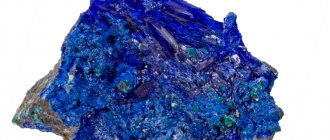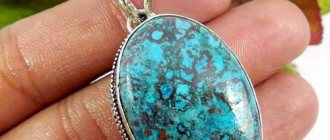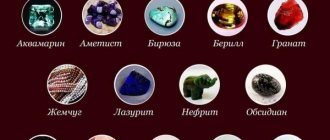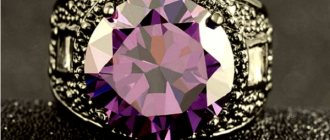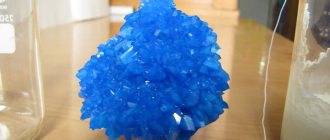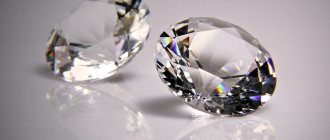Few people can boast that they have a gemologist among their friends. However, it is impossible to imagine any jewelry business today without such an expert. Moreover, if trade in gems is allowed in the country, then there is also a state gemological laboratory. Ordinary buyers do not often turn to this expert, but any gems purchased legally have passed through the hands of a gemologist.
Mineralogy
Mineralogy is a science that studies natural chemical compounds called minerals, namely their properties, composition, structure and conditions of genesis. This is one of the basic geological disciplines.
History of science
Mineralogy is the oldest among geological sciences. It appeared much earlier than geology emerged as an independent scientific field. The first mineralogical observations date back to ancient times. They are first found in the works of Aristotle, where he identified a group of metalloids as metal-like formations and classified minerals into ores and stones. Theophrastus described in practical terms 16 mineral species, dividing them into stones, metals and earths. Later, Pliny the Elder collected all the data on minerals available at that time in four treatises.
Further, mineralogy developed thanks to mining.
In the Middle Ages, the development of geological sciences took place most intensively in Arab countries. One of the outstanding scientists in this field is Biruni. He created descriptions of gemstones using physical parameters such as relative hardness and specific gravity for the first time. At the same time, Ibn Sina classified known minerals into soluble (salts), earths and stones, combustible (sulphurous) minerals, fusible (metals). During this period in Europe, the alchemist Albertus Magnus combined data on minerals.
By the end of the Middle Ages, mineralogical knowledge was very scarce. Many minerals were understood as ores. Due to the lack of chemistry, there was no data on their chemical nature.
In the 16th century V. Biringuccio and G. Agricolla compiled summaries of mineral knowledge. The latter improved Ibn Sina's classification. He also described in detail the diagnostic features and touched upon the genesis of ore deposits.
In the 17th century Danish, Dutch and English scientists laid the foundation for geometric crystallography and crystal optics.
By the 18th century Sweden played a major role in the field of mineralogy thanks to its mining industry. Therefore, a group of mineralogists was formed here, among whom were K. Linnaeus and A. Kronstedt. The first tried to use a double nomenclature for minerals, and the second excluded organisms from the object of study and studied the chemical composition.
At that time, mineralogy was still understood as a scientific discipline with a much broader subject of study than it is now. Thus, in 1636, this term was introduced into literature by Bernard Caesius as a science about all natural fossil bodies. That is, there was a single geological and mineralogical direction of natural science.
It was divided in 1780 by A.G. Wegener on geognosy (general and dynamic geology), oryctognosy (mineralogy and petrography), mining art (mining). Thanks to this, mineralogy acquired a more specific object of study (rocks and fossils were separated from minerals). In addition, new classifications, descriptive methods of study, nomenclature, and training courses have appeared.
In 1783 J.B. Romé de Lisle measured the interhedral angles of crystals of some minerals, R.Zh. Ayui in 1801 created a model of their structure. This, together with the work of W. Wolaston, contributed to the development of crystallography.
V.M. is considered the first Russian mineralogist. Severgina. Continuing the ideas of M.V. Lomonosov, he divided fossil bodies into simple (minerals) and complex (rocks and fossils).
In the 19th century chemical and crystallographic directions of mineralogy arose. Many fundamental concepts have emerged.
In the 20th century, thanks to the doctrine of the rule of phases, physicochemical and experimental directions developed particularly intensively. In addition, the synthesis of various branches of mineralogy began.
From the second half of the 20th century, such areas as organic, bio- and nanomineralogy began to develop.
Modern mineralogy
Currently, this discipline includes several areas.
Descriptive. Characterizes minerals, systematizes and classifies them. Includes two sections: mineral physics (uses solid state physics methods to study crystals) and mineralography (uses specific methods such as microchemical reactions, reflected light optics, etc.).
Genetic. Explores the methods and processes of the genesis and transformation of minerals in natural conditions. Also includes several sections: topomorphism (reveals the relationships between the characteristics of minerals and the conditions of their genesis), thermobaro-geochemistry (studies inclusions in minerals), isotopic studies (determining the source of the substance for mineral formation), triphogenesis (studies methods of nutrition during mineral formation), topogenesis (considers the laws spatial distribution of minerals), paragenetic analysis (identification of laws of sequential spatial and temporal change of parageneses to study the evolution of mineral formation), the study of coexisting minerals (using them as geobarometers and geothermometers), energy and thermodynamic calculations (assessment of the acid-base properties of mineral phases), ontogenetic and crystal morphological analysis (clarification of the history and mechanism of mineral genesis).
Experimental. He is engaged in modeling natural mineral formation and the environment of mineral formation. Includes their refinement and synthesis as a separate section.
Regional. Explores individual territories such as ore deposits, geological provinces, economic-geographical regions in order to clarify the laws of the spatial distribution of associations and minerals.
Topominerology. Considers the laws of their formation and distribution in geological systems.
Mineralogy of cosmic bodies. Explores mineralogical questions for planets, meteorites and the moon.
Astromineralogy. A promising direction that combines mineralogy, astronomy, and physics. Studies the mineral composition and minerals of meteors, asteroids and other cosmic bodies, the circumstellar environment.
Applied. Includes three sections: prospecting mineralogy (dealt with the clarification of prospecting and exploration criteria, improving prospecting and evaluation methods, developing the scientific basis for combining mineralogical, geochemical and geophysical prospecting methods in order to increase the efficiency of geological exploration), technological (aimed at increasing the completeness and complexity of the use of mineral raw materials by mineralogical and mineralogical-technological mapping of deposits and ore fields, technological forecasting, stabilization and planning of ore mining, studying the technological characteristics of minerals, developing methods for their directed change, monitoring the composition of concentrates), new types of raw materials (reveals the characteristics of unused minerals and possible areas of their application ).
List of minerals
If you show all known minerals in one list, you will get a lot of names for one page.
Subject, tasks, methods
The objects of study of mineralogy are individuals, aggregates and their associations.
Objectives of mineralogy:
- creation of a classification of minerals;
- establishing relationships between variations in their structure, composition, properties and conditions of formation;
- development of scientific foundations for the search and exploration of mineral deposits;
- improving processing technologies and using new types of raw materials;
- development of methods for refining and creating minerals.
In mineralogy, field and laboratory methods of determination and analysis are used. In addition, thermal, radiographic, optical, as well as various precision physical, isotopic, thermobarogeochemical methods, and quantitative phase analysis are used.
Education
In universities, mineralogy is not presented as a separate specialty. Training in this profession is most often carried out within the specialty of applied geology or applied geochemistry. They involve the study of general geology, the fundamentals of cartography and geodesy, mathematical modeling methods in geology, safety of geological exploration, engineering graphics, general chemistry, many specialization disciplines, etc.
Laboratory work and field minelogical practices are provided. In addition to the mineralogist, training provides such professions as geologist, geochemist, geocryologist, hydroecologist, topographer, hydrogeologist, surveyor, ecologist, petrologist, paleontologist.
In the “classic form” it is not particularly in demand. Most specialists work in the scientific or educational fields. Therefore, the above-mentioned universal specialties are advantageous in that they provide the opportunity to work in several professions.
Rock groups
Based on their origin, rocks are divided into three groups:
- Igneous (effusive and intrusive)
- Sedimentary
- Metamorphic
Igneous and metamorphic rocks make up about 90% of the volume of the earth's crust, but on the modern surface of the continents the areas of their distribution are relatively small. The remaining 10% comes from sedimentary rocks, occupying 75% of the earth's surface area.
Igneous rocks, based on their origin, are divided into effusive and intrusive. Effusive (volcanic) rocks are formed when magma flows onto the Earth's surface. Intrusive rocks, on the other hand, arise when magma flows deep into the earth's crust.
The division of rocks into igneous, metamorphic and sedimentary is not always obvious. In sedimentary rocks, during the process of diagenesis, already at very low (in the geological sense) temperatures, mineral transformations begin, but the rocks are considered metamorphic when newly formed granite appears in them. At moderate pressures, the onset of metamorphism corresponds to a temperature of 300 °C.
At high degrees of metamorphism, the line between metamorphic and igneous rocks is blurred. The melting of rocks begins, the mixing of newly formed melts with clearly external ones. Gradual transitions from clearly metamorphic, banded rocks to typical granites are often observed. Such processes are referred to as ultrametamorphism.
Mantle rocks stand out separately. On the one hand, the conditions in the mantle are such that even if the rock was originally igneous, it would still undergo changes in the mantle. In general, for the main volume of the mantle, the question remains debatable whether it was once in a molten state. On the other hand, in mineralogy, mantle rocks are largely identical to igneous rocks. Therefore, the nomenclature of igneous rocks with variations is applied to them.
There are igneous complexes whose textural features resemble the textural features of sedimentary rocks. These are layered main intrusions. In some of them, gradational layering, cross-bedding, rhythmic structure of the strata, and the presence of accumulations of heavy minerals, typical of sedimentary rocks, are observed.
However, instead of sedimentary siltstones, sandstones and gravelstones, such complexes are composed of ordinary igneous rocks. The formation of such objects was repeatedly explained by the metamorphism of sedimentary rocks, but such an interpretation could not explain the presence of sharp contacts between the complex and the host rocks.
Petrography deals with the description and classification of igneous and metamorphic rocks, and petrology studies their genesis. Lithology deals with the description, classification and analysis of the conditions for the formation of sedimentary rocks, in which there is an independent section - petrography of sedimentary rocks.
Closely related to lithology is the related sedimentology, which studies the conditions for the formation of modern sediments. Since there are no strict definitions of the concepts "sediment" and "sedimentary rock", the difference between sediment and sedimentary rock is not always clear. These sciences are closely related to geochemistry and mineralogy.
Based on the depth of formation, rocks are divided into three groups: rocks that crystallize at depth - intrusive rocks, for example, granite. They are formed during the slow cooling of magma and are usually well crystallized; Hypabyssal rocks are formed when magma solidifies at shallow depths, and often have irregular grain structures (dolerite). Effusive rocks form on the earth's surface or on the ocean floor (basalt, rhyolite, andesite).
The vast majority of natural magmas contain silicon as the main component and are silicate melts. Carbonate, sulfide and metal melts are much less common. Carbonate igneous rocks—carbonatites—are formed from carbonate melts. In the 20th century, several volcanic eruptions with carbonatite magmas were recorded. Sulfide and metal melts are formed due to immiscibility and segregation with silicate liquids.
The most important characteristic of igneous rock is its composition. There are several classifications of igneous rocks based on composition (rock nomenclature). The most important classification is based on the content of silica SiO2 and alkalis (Na2O K2O) in rocks. Based on their alkali content, rocks are divided into series.
Rocks of the normal, subalkaline and alkaline series are distinguished. A formal sign of such division is the appearance of specific alkaline minerals in the rock. According to the SiO2 content, rocks are divided into ultrabasic - SiO2 in the rock is less than 45%, basic - if the SiO2 content is in the range from 45% to 54%, medium - if from 54 to 65%, and acidic - if the SiO2 content is more than 65%.
The formation of igneous rocks continues to occur even now, in zones of active volcanism and mountain building.
The science of gemstones
The science that studies precious and semi-precious stones, as well as artificial imitations of gems, is called gemology. The name comes from the root gemma, which means “gem, precious stone” and the word “logos”, which translates as “word, science”. The scope of scientific interests of gemology includes the study of the chemical composition of minerals and organic rocks, their structure, physical and optical properties, origin, as well as determining the value and decorative and artistic merits of gems.
Gemology, as a separate branch of knowledge, began to stand out at the end of the 19th century. The need for scientists specializing in valuable types of minerals and rocks of organic origin was caused by the widespread prevalence of high-quality fakes and imitations.
Science as a part of geology intersects with petrography, crystallography and mineralogy, of which it was an offshoot.
Gemology uses methods used both in geology and in chemistry, physics, and biology. An important feature is its applied focus and connection with jewelry and stone-cutting production.
Gemology solves the following problems:
- description of minerals, stones of organic origin and natural inclusions;
- optimization of processing and cutting technologies;
- evaluation of gems and determination of their value;
- determining the type and origin of samples, and developing appropriate effective procedures;
- checking stones for authenticity and identifying synthetic imitations;
- development of methods for refining semi-precious and precious minerals and identifying cases of their use;
- study of methods for obtaining and properties of synthetic stones.
Precious and jewelry stones from the point of view of gemology
The development of gemology marked the beginning of the classification of valuable minerals. Although it is worth mentioning right away that even now there is no single definition of the concept of a precious stone.
Most often, this is the name given to rare and beautiful specimens (or combinations thereof) with high hardness. Hardness is one of the main characteristics, which means that the stone is not subject to abrasion or mechanical damage. Such minerals are practically timeless.
If the hardness of a mineral is a more or less constant parameter, then beauty is a relative concept. Throughout history, ideas about it have changed. And sometimes radically. This has led to the fact that minerals that were once considered precious are now almost forgotten. And nondescript ones, from the point of view of ancient people, can now be called that.
The term semi-precious stone is often used. This name is not entirely correct from a scientific point of view, but is widespread in trade and among ordinary people. In general terms, this is the name given to less valuable and hard rocks.
Jewelry or ornamental is rather a collective name for all minerals for jewelry. Although this is often what inexpensive nuggets are called. Unlike gems, they are often used in arts and crafts or stone cutting.
Attempts to classify minerals have been made repeatedly. In each period of history, approaches to systematization differed. Often they were based on ranking by cost. Heated debates about which minerals are considered precious and which are not did not cease for a long time.
The only thing on which the opinions of scientists have always agreed is that the most valuable nuggets are:
- diamond;
- emerald;
- ruby;
- sapphire (blue).
Now there are many classifications. They are based on the distribution of minerals into groups based on the degree of their strength, hardness, composition, and method of formation. Some of them were developed more than a hundred years ago, but are still relevant today. True, due to the discovery of new minerals and compounds, they are periodically supplemented.
An abbreviated version of the distribution of minerals into groups, understandable to the average person, is given in the book “Wonderful Minerals”:
| Type | Description | Kinds |
| Gems (precious stones) | Minerals with a high degree of strength and transparency. The color range is varied (colorless samples are not uncommon). The structure is crystalline (with rare exceptions - turquoise, schorl, opal and some others). | I order:
II order:
III order:
|
| Ornamental (semi-precious) stones | Stones (rocks) with varying degrees of hardness, distinguished by beautiful patterns and colors. Translucent or completely opaque. |
|
But according to the author, there are no clear boundaries between classes. Sometimes a precious mineral belonging to the first order is valued lower than a semi-precious stone of the second class due to various defects. Although, there are often cases when skillful processing, polishing or cutting a crystal turned a mineral defect into an advantage.
Modern science
Gemology is most closely related to such geological sciences as mineralogy, crystallography and petrography. This is explained by the fact that most precious and semi-precious stones are minerals. Now this discipline has several directions: diagnostic (determining the type of stone and distinguishing between natural and synthetic minerals), genetic (finding the origin of gems), descriptive (studying the characteristics of stones), experimental (studying the possibilities of using stones not used here in jewelry), regional ( research of gems of a certain territory), aesthetic (change in the external properties of stones: cutting, color change, etc.), applied and technical and economic (development of new methods for refining and processing gems and optimization of existing technologies), evaluative (determining the value of stones based on their origin, properties, degree of processing, etc.), glyptics (a special method of external processing of gems, consisting of applying a three-dimensional image to the surface).
Therefore, gemology is primarily an applied science. Even research tasks are aimed at using the information obtained or developments in the production and trade of stones. Thus, determining the mineral type of a gemstone and its origin, as well as the difference between natural gems and artificial analogues is necessary for evaluating stones for trading. The development of methods for refining and processing gems is required for jewelry production.
In countries where trade in stones is permitted, there are state gemological laboratories. In addition, there are also private ones. They are found in countries where diamonds are traded. Here, gemologists evaluate stones, acting as a third party in transactions.
Properties of stones studied by gemology
Over the entire history of the development of the science of stones, more than 3 thousand minerals have been identified and classified into separate groups. Many of which, having similar external characteristics and even structure, still belong to different classes.
It is very difficult for a non-professional to identify the differences between gemstones that are similar to each other. Gemologists can do this. Diagnostics is carried out using special equipment in a laboratory setting.
The main characteristics of precious, semi-precious and ornamental stones are:
- Chemical composition. Which also affects the physical characteristics of the mineral. Native elements, sulfides, oxides, carbonates, sulfates, phosphates, silicates are distinguished.
- Hardness. Previously, it was determined by the scratching method, rated on the Mohs scale from 1 to 10. Ten is the highest. The reference stone is diamond. This method has one big drawback. The surface of the mineral can be damaged. Nowadays, the scratching method is used mainly by amateur jewelers and collectors. The hardness indicator tells you how to work with the stone further, what type of cutting or polishing to choose.
- Kink. Fracture is the shape of the fragments of stone into which it splits upon impact. It can be conchoidal, splintered, smooth, stepped, etc. An important feature that allows you to distinguish minerals. For example, the group of quartz or glass products is characterized by conchoidal fracture.
- Cleavage. Cleavage is a parameter necessary for proper cutting, polishing, and choosing a frame. Depends on the building. There is very perfect, perfect and imperfect.
- Density. The ratio of the mass of stone and water in the same volume. Rated on a scale from 1 to 7. Valuable minerals always have high density.
Optical properties of jewelry
The optical properties of precious stones also play a major role in the study of stones. Many imitations or synthetic crystals do not have such characteristics as luminescence, shine and some others.
Among the optical properties, the main ones are:
- Color. The color variation of many stones is diverse, so color is not always a diagnostic sign. Even a diamond can be colorless, yellowish or black. The color depends on various chemical admixtures in the composition and the light source. For example, sapphire looks more impressive in natural light than in artificial light.
And ruby is the opposite. Alexandrite turns green during the day and red in the evening.
- Trait color. An important characteristic that allows you to distinguish minerals of similar color. The test is very simple: a stone is passed over the surface of unglazed porcelain with strong pressure. The color of the line indicates whether the mineral belongs to a certain group, its natural or artificial origin.
- Light refraction. Another important characteristic. Produced with a refractometer. Sometimes measured by immersing a stone in a liquid.
The optical effects inherent in many gems that appear after polishing are very interesting:
| Name | Characteristic |
| cat's eye | When turning, a narrow strip of light runs across the surface, reminiscent of a cat's pupil. It is very valuable in chrysoberyl, but is manifested in many minerals. |
| Asterism | A glare of light resembling a star. |
| Adulariscence, moonstone effect | A whitish-blue shimmer (overflow) sliding across the surface. |
| Adventurism | Sparkling, motley (sometimes brilliant) reflections of light. |
| Irisation | Rainbow play of colors. Sometimes it is created artificially by adding cracks in the structure. |
| Labradorescence | Shimmering metallic tones (blue, red, green). |
| Opalization | Flickering of colored sparks due to cristobalite inclusions. |
| Silk | Shine and shimmer, which are very valuable in rubies and sapphires. |
Of course, all of the above properties that the science of stones studies are far from the only ones.
But they are basic when studying a particular mineral. The science of stones, mineralogy, and its narrower branch, gemology, are among the most ancient teachings. Philosophers and great thinkers of Ancient Hellas and Rome, scientists of the Middle Ages and today devoted their works to descriptions of precious stones and their properties.
Over thousands of years, the methods that make it possible to distinguish between minerals and the criteria that determine their value have changed. Only one thing has remained unchanged - like many centuries ago, gems continue to amaze the human imagination with their beauty and magical power.
Subject, tasks and methods of gemology
The subject of gemology is ornamental and precious stones. It should be noted that most of them relate to minerals. Thus, approximately a third of all known minerals are used in jewelry. In addition to minerals, gemology studies non-mineral bodies, such as non-crystalline formations, organogenic products, and synthetic analogues of minerals.
The objectives of this science include the development of diagnostic criteria for synthetic and natural gems, expanding the possibilities of using known stones and studying the areas of use of species not involved in the jewelry industry, developing methods for the synthesis of artificial gems and improving the technologies used.
There are several promising tasks: the accumulation of diagnostic data for a more accurate and reliable identification of stones, the study of the color of gems using computer modeling, the study of the optical properties of diamonds and optimization of their cutting, the study of methods for refining stones and the creation of technologies for its recognition, the study of the differences between artificial gems and natural analogues and their specific properties. This discipline applies methods of petrography, chemistry, geology, physics, and biology. Optical methods are of great importance in gemology. Their advantage is that such technologies make it possible to diagnose stones without exerting physical influence on them. This is especially relevant given that gemologists often have to identify treated stones that cannot be noticeably affected. Optical methods include color dispersion, measurement of light refractive indices, intensity and nature of luminescence, etc. To distinguish natural stones from artificial ones, determination of the composition is usually required. For this purpose, electron paramagnetic resonance, ultraviolet and infrared spectroscopy are used, and the composition and phase relationships of gas-liquid and solid inclusions are analyzed. Upgrading is carried out by enhancing or changing the color. For this purpose, methods of ionizing radiation, annealing (thermal exposure), and impregnation with chemically active substances are used.
That is, in terms of the methods used, gemology is also close to mineralogy. The difference is that gemologists very often have to examine processed gemstones, which cannot be noticeably affected, therefore, optical diagnostic methods are more widespread.
Scientists studying stones
The profession of a person who studies precious crystals and organic formations (pearls, amber) is called “gemologist”. In the jewelry business, such an expert is the most important. A professional can quickly distinguish a real stone from an imitation, determine the type and tell about the origin of the natural mineral. People involved in this science also work with synthetic stones.
Responsibilities of specialists
The need for specialists studying precious crystals arose as a result of the mass production of counterfeits. Since, due to the development of technology, it has become difficult to distinguish a natural stone from an imitation, one of the main tasks of gemology is diagnostic. Science studies the chemical composition, external characteristics of minerals, as well as the quality of finished jewelry. The responsibilities of a gemologist include:
Gemologists spend a lot of time studying imitations, know how to refine crystals, and work to optimize methods of processing gemstones. The main equipment for them is a refractometer, spectroscope, magnifier and microscope. There are many differences between a jeweler and a gemologist: the first granite sets and repairs products, and the second evaluates stones and monitors the work performed. Often an employee combines these two specialties.
Gemologist
Gemology is a science that studies the chemical composition of precious stones, their physical properties, and the quality of jewelry.
Accordingly, a gemologist is involved in identifying, evaluating and certifying gemstones. A professional gemologist can easily determine the type of gemstone and its origin, distinguish synthetic analogues and imitation gemstones from natural gemstones.
To do this, a gemologist must know the methods of refining precious and ornamental stones. His main tools are his eyes, magnifying glass, microscope, refractometer and spectroscope. This is a rather rare and therefore in-demand profession, both in our country and abroad.
Education and work of a hemologist
Since gemology is a narrow specialty, training in this profession is carried out within the framework of geology, geochemistry, crystal physics, and technology for processing precious stones and metals. And if the first two specialties are very common, then the others are rare. In addition, there are courses in gemology outside of the higher education program.
In Russia, gemologists are in little demand. This is explained by the fact that the practice of their participation in gem trading transactions as a third party (appraisers) is not developed here. Moreover, many people involved in this field do not even know about the existence of such specialists. Therefore, in Russia, gemologists mainly work in the production of jewelry, while in other countries they are actively involved in the trade of stones and goods made from them.
General information
Gemologist is a profession in demand around the world. This specialist finds out the type of stone just by looking at it. He easily determines the location of a gem, studies its features, and examines its chemical composition and properties. He also evaluates the quality of jewelry. A professional in his field knows various methods of refining and cutting stones. In his work he uses microscopes, magnifying glasses, and spectroscopes. But his main tool is his eyes. The work is complex, but quite interesting, it is suitable for people interested in world artistic culture, geography and jewelry.
A gemologist must have acute vision and normal color perception. He also cannot do without perseverance and concentration. After all, for a comprehensive analysis you will need to spend a lot of time even with one small stone.
Profession requirements
If we talk about what the responsibilities of a gemologist are, we can highlight the following points:
- the master sorts the stones before processing them, that is, sorts them according to color, shape and other criteria for the quality of the mineral and the number of defects;
- A gemologist can classify specimens that are identical in most respects into one category and create a set of stones that will be sold;
- if the product requires repair, the gemologist will select a stone that will replace the previous option;
- it is this person who makes the calculations for the pieces that go to production or a jewelry factory, and also evaluates each of them according to their characteristics;
- he accounts for and controls the remaining material left by the jewelers at the factory;
- The gemologist draws up a description of the products that have arrived, proposes a procurement plan to the company and compares the prices of stone mining companies.
There are several differences between a jeweler and a gemologist. Jewelers are directly involved in the production of products: they cut stones, set them, and carry out repairs. And gemologists control the quality of the stone and the jewelers’ work itself. But these two professions are not mutually exclusive, so we often meet representatives of jeweler-gemologists who combine two activities.
Gemologist
The profession of a gemologist is complex and requires certain skills and qualities. Objectively speaking, it is difficult for an ordinary student to get into this field after university, since jewelry making is an industry that is famous for its continuity. Therefore, new people will have to prove their skills for many years before they are entrusted with truly important work.
A representative of the profession must also have the following qualities:
- Good eyesight, since you will have to work with small objects and look into details.
- The perception of color must be complete, since there are many shades of stones and each has subtleties.
- Perseverance and concentration. Almost the whole day you will have to sit in a laboratory or office, looking at stones.
- Responsibility, since the amounts of transactions with stones are large and there should be no errors during verification.
Gemologist is a youth profession because it requires concentration and good perception. And also about 70% of its representatives are women. Perhaps this is due to their perseverance.
Of course, the profession is a little monotonous, so it is better to choose it only when you are really interested in stones, and not in the thirst for making money. Most gemologists have higher education in their specialty. The faculty chosen by future representatives of the profession is geological or mineralogical, followed by career guidance in the fifth year. However, you should know that gemologists graduate with one of two types of diplomas: colored or white. A white diploma is awarded to diamond specialists, and a colored diploma is awarded to specialists in other stones.
But in order to obtain a license, gemologists need to take additional advanced training courses, which include practice. Such courses are expensive and are located in Russia only in large cities.
Responsibilities
A gemologist has quite a few responsibilities, but we will list the main ones:
- A specialist needs to sort stones, taking into account their size, shape and quality.
- Select sets of gems.
- Select stones for jewelry repair.
- Prepare invoices for movement.
- Calculate the cost of products that come into production.
- Evaluate gems in finished jewelry.
- Control the remains of jewelry.
- Monitor deadlines and contact suppliers.
- Analyze cost data.
- Make proposals for purchases.
Also, a specialist in this profession prepares gemological descriptions for products that have been received by him.
Responsibilities
A gemologist has quite a few responsibilities, but we will list the main ones:
- A specialist needs to sort stones, taking into account their size, shape and quality.
- Select sets of gems.
- Select stones for jewelry repair.
- Prepare invoices for movement.
- Calculate the cost of products that come into production.
- Evaluate gems in finished jewelry.
- Control the remains of jewelry.
- Monitor deadlines and contact suppliers.
- Analyze cost data.
- Make proposals for purchases.
Also, a specialist in this profession prepares gemological descriptions for products that have been received by him.
What does a cutter do?
In this section of the article we will give a basic list of functional responsibilities that an organ operator performs.
These include:
- Complete technological processing of the precious stone;
- Selects the most optimal cutting method for each individual sample;
- Makes initial and final cuts;
- Keeps all working tools in order;
- Monitors the technical condition of mechanical devices and performs their timely maintenance;
- Restores stones that have lost their shine during use for various reasons.
What personal qualities should a gemologist have?
It is widely known that in addition to interest in the specialty, as well as innate abilities, the personal qualities of a person are important, taking into account all the nuances of the future profession, as well as the state of his health. In this regard, one cannot fail to note the mandatory requirement for gemologists. Since a specialist’s eyes are his main “tool” of work, a gemologist must have excellent vision. Here it must be especially emphasized that diseases such as color blindness are completely incompatible with the profession.
Today in the world there are more than 30% of fake minerals. Therefore, buyers who want to verify the authenticity of the stones they are purchasing order an expert opinion from a gemologist. A gemological examination is a legal document that confirms the authenticity of a mineral and determines the value of the stone, as well as the honesty and professionalism of the specialist who sold the gem.
Since a gemologist’s mistake can have the most dire legal consequences, a specialist must have the following qualities:
Considering that precious stones attract the attention of wealthy people, collectors and criminals alike, a gemologist must take care of his own impeccable reputation and safety in rather difficult conditions. He would benefit from additional knowledge in the field of law and finance, which requires high learning abilities.
And communication with clients will require developed communication skills, observation and knowledge of psychology.
Important qualities
To achieve success in the professional field, an expert gemologist, in addition to knowledge, must have the following innate qualities:
- Keen vision , since the eyes are the main tool of a gem specialist. Mostly at work you will have to deal with small objects.
- Good color perception is necessary to distinguish subtleties in the color and shades of stones.
- Perseverance and the ability to concentrate on one task for a long time.
- Attention to detail.
- Responsibility and resistance to stress are necessary qualities for a gemologist, since part of his work consists of filling out documents, expert opinions and conducting transactions for large sums.
Features of the profession
The responsibilities of a gemologist include:
- sorting of stones (by size, shape and quality)
- selection of stone sets
- selection of stones for repairing products
- registration of invoices
- calculation of the price of incoming products
- evaluation of stones in products (characteristics)
- control of current stone residues
- control of delivery times of stones from suppliers
- analysis of information on supplier prices
- submission of procurement proposals
- accounting of stones by groups and sizes
- preparation of gemological descriptions for incoming products
- reconciliation with production
Salary of gemologists
The salary of a specialist depends on factors such as:
- experience;
- level of qualifications that can be increased and an additional license obtained after completing the courses;
- amount of work and responsibilities.
The average salary for gemologists in Russia is $250 in the regions and up to $600 in big cities. Compared to the raw materials that gemologists work with, their salaries seem meager. This happens because representatives of this profession rarely become intermediaries between the seller and the buyer of the stone. There is a thriving black market in jewelry trading, which does not require documentary proof of authenticity. And most buyers trust stores and are not interested in stone certificates.
Gemology is the science of precious stones, which has not yet lost its relevance and popularity. But there is no high demand for gemologists, and there are few high-paying vacancies on the labor market. Assessing and checking stones is not an easy job, but abroad it is more accessible to those interested.
Personal qualities of a gemologist
Successful work requires not only knowledge of the basic properties and characteristics of precious and semi-precious stones. It takes many hours of practice to reduce the number of errors. Practice is also required in order to learn new technologies and more accurately determine the characteristics of stones.
The following qualities are required for the job:
- Perseverance.
- Attentiveness.
- Scrupulousness.
- Responsibility.
It is also important for a specialist to understand the characteristics of precious stones, their cost and quality.
Where do they teach
To become a gemologist, you need to enroll in the Faculty of Geology or Mineralogy and in the fifth year choose the specialization “Gemology” or the corresponding department.
There are gemologists with a colored and a white diploma. The first is given to a gem specialist, the second to a diamond specialist.
- Gemological Center at Moscow State University 119991, Moscow, GSP-1, Leninskie Gory, Main Building of Moscow State University, A-429 Tel.: (495) 939-4973; tel./fax: (495) 932-8894
- MISiS Moscow Institute of Steel and Alloys.
Today, gemological training at the Geological Faculty of Moscow University is carried out at all levels of state higher education (bachelor's, five-year higher education, master's, postgraduate studies), as well as in the form of additional education (vocational training courses).
Russian gemological education is one of the best in the world. The Gemological Center of Moscow State University, which has existed since 1995, has become a recognized educational center in Russia with high authority both in our country and abroad.
Education
If you decide to get this profession, then you need to study at the Faculty of Geology or Mineralogy. But when you move on to the 5th year, you need to choose a specialization called Gemology. Such specialists may have a colored or white diploma. The first is for professionals who know about precious stones, the second is for those who know about diamonds.
In the Russian Federation today, education in the described profession occupies a leading position in the world.
Potential employers
The services of a gemologist are in demand among companies and organizations that work with valuable stones (extracting, processing or selling), carry out expert assessments of gems and identify fakes, or train young experts. A gemologist can find work in the following organizations:
- higher education institutions;
- expert departments at museums;
- international gemstone exchanges;
- public or private gemological laboratories;
- jewelry companies and factories;
- pawnshops.
Pros and cons of the profession
Many educational institutions offer everyone who wishes to take short-term courses in gemology for a wide range of students. They will teach you how to navigate the world of gems and tell you what signs of stones to look for in order to identify a fake. But after such courses you cannot apply for the position of a full-time gemologist.
To become a professional who can find a job in the field related to precious stones, you will need to go to university, study and remember a lot of information. The learning process does not end with receiving a diploma. To gain experience, you will need to complete an internship, attend additional training courses and obtain a license or work as an assistant to a professional.
The main advantage of this profession is its rarity and demand.
However, only recognized experts with extensive experience can count on interesting work and decent pay.
Salary
The level of remuneration for a specialist is determined by the list of job responsibilities, professional knowledge and skills, and work experience. The salary is low: from 15 thousand rubles in the regions to 35 thousand in the capital, this is tens of times less than the cost of the raw materials with which gemologists work. An expert at the Gemological Center of Moscow State University, Dmitry Sinev, assesses the situation with the salaries of gemologists: “In Russia, the salaries of these specialists reflect the level not of qualifications, but of demand. We have not yet developed enough practice where a gemologist acts as a third party in a transaction between a seller and a buyer. Many people simply don’t know that such specialists exist.”
Short story
The profession of gemologist is considered relatively new. It arose quite recently - in the 20th century. In 1908, the world's first specialized institution, the Gemological Committee, appeared in Great Britain. Its creator was the National Association of Jewelers of Great Britain (NAG). It was then transformed into the Gemological Association (Gem-A). In 1928, the first graduates of the institute began working at this institution.
Today, every country with a legal trade in precious stones has public gemological laboratories. In addition to them, of course, there are also private ones - they, as a rule, open in places where diamonds are regularly traded (for example, in regions where international specialized exchanges for the sale of diamonds are established). This allows you to minimize the risks of purchasing counterfeit or low-quality products.
Story
Gemology appeared together with mineralogy as a non-separate direction. Moreover, the first mineralogical works were mainly about precious stones, their characteristics and diagnostic methods.
In ancient Rome, such research was carried out by Pliny the Elder, and in the medieval Islamic world by Biruni. The development of mineralogy and gemology occurred together with the accumulation of knowledge about minerals until the end of the 16th century. within the framework of a single geological and mineralogical direction of natural science, when it began to separate.
The first book on gemstones was written by 1652 by Thomas Nichols.
In Russia, gemological work appeared only in the 19th century. Such research was carried out by V. M. Severgin and M. I. Pylyaev.
In 1837, Marc Gaudin created ruby crystals by jointly melting potassium chromate and potassium alum. This is the first case of artificial cultivation of precious minerals.
Modern gemology was formed by the beginning of the 20th century, when precise methods for studying mineral matter appeared.
Thus, in 1866, Arthur Church used the first spectroscope to study stones, and in 1902, Herbert Smith created a specialized instrument for measuring the refractive index of crystals - a refractometer.
In 1908, the Gemological Association of Great Britain was formed. Robert Shipley, who received her diploma in 1929, founded the Gemological Institute of America in 1931.
In the mid-30s. Anderson and Payne created several stable, safe, heavy liquids for determining the specific gravity of minerals.
After World War II, R. Webster developed a technology for identifying precious minerals using ultraviolet rays.
In 1959 L.Ch. Trumper created a device for diagnosing precious stones by reflectivity (reflectometer).
In the 70s Such devices have become widespread, as have thermal conductivity meters. In 1986, the first commercial computer program for identifying precious minerals was introduced. 10 years later, two devices were created to distinguish synthetic diamonds from natural ones.
Career steps and prospects
Considering that salaries for unlicensed gemologists are low, obtaining additional education and certification is the only way to make a successful career. To gain the opportunity to work independently, you can undergo additional training at gemological courses, which are available in Moscow, St. Petersburg, and Yekaterinburg. Studying at Moscow State University will cost 60 thousand rubles for a month and a half, at MISiS - 300 thousand for a year. Yekaterinburg offers additional training for less money - 20 thousand rubles for a two-week course.
Portrait of a modern gemologist:
The age range of gemologists most in demand on the labor market is 20-40 years; specialists under the age of 30 make up about 64% of the total, and those between 30 and 40 years old make up about 24%.
92% of gemologists have completed higher education.
72% of gemologists are women.
